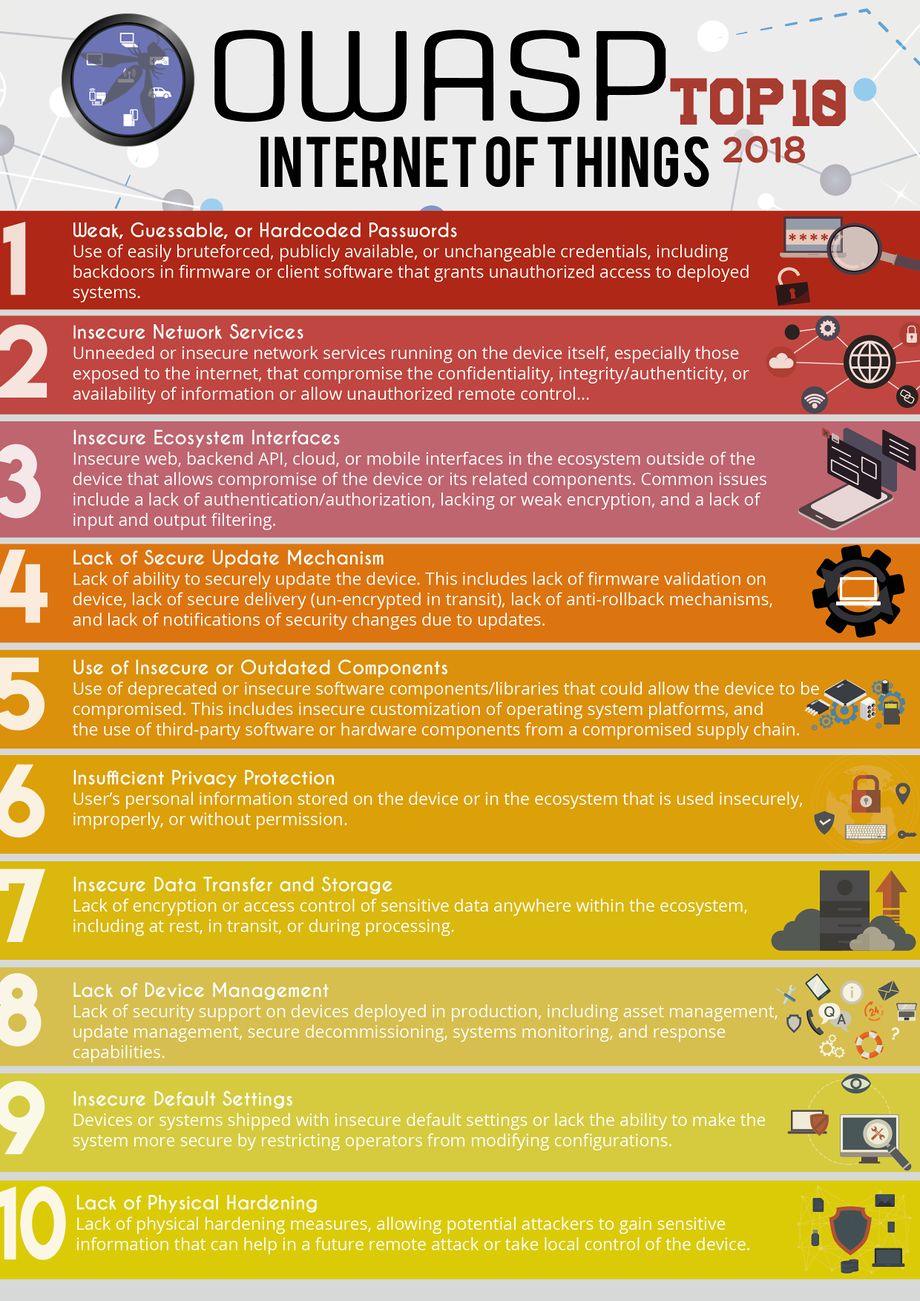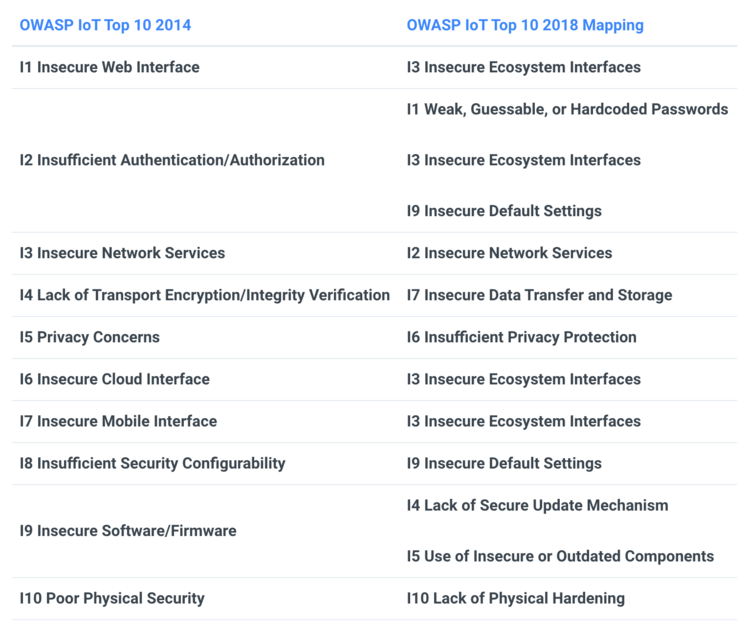This site is the archived OWASP Foundation Wiki and is no longer accepting Account Requests.
To view the new OWASP Foundation website, please visit https://owasp.org
OWASP Internet of Things Project
- Main
- IoT Top 10
- OWASP IoT Top 10 2018 Mapping Project
- IoTGoat
- ByteSweep
- Firmware Security Testing Methodology
- IoT Attack Surface Areas
- IoT Vulnerabilities
- Medical Devices
- Firmware Analysis
- IoT Event Logging Project
- Project About
OWASP Internet of Things (IoT) ProjectOxford defines the Internet of Things as: “A proposed development of the Internet in which everyday objects have network connectivity, allowing them to send and receive data.” The OWASP Internet of Things Project is designed to help manufacturers, developers, and consumers better understand the security issues associated with the Internet of Things, and to enable users in any context to make better security decisions when building, deploying, or assessing IoT technologies. The project looks to define a structure for various IoT sub-projects separated into the following categories - Seek & Understand, Validate & Test, and Governance. Updated!The OWASP IoT Project for 2018 has been released!PhilosophyThe OWASP Internet of Things Project was started in 2014 as a way help Developers, Manufacturers, Enterprises, and Consumers to make better decisions regarding the creation and use of IoT systems. This continues today with the 2018 release of the OWASP IoT Top 10, which represents the top ten things to avoid when building, deploying, or managing IoT systems. The primary theme for the 2018 OWASP Internet of Things Top 10 is simplicity. Rather than having separate lists for risks vs. threats vs. vulnerabilities—or for developers vs. enterprises vs. consumers—the project team elected to have a single, unified list that captures the top things to avoid when dealing with IoT Security. The team recognized that there are now dozens of organizations releasing elaborate guidance on IoT Security—all of which are designed for slightly different audiences and industry verticals. We thought the most useful resource we could create is a single list that addresses the highest priority issues for manufacturers, enterprises, and consumers at the same time. The result is the 2018 OWASP IoT Top 10. MethodologyThe project team is a collection of volunteer professionals from within the security industry, with experience spanning multiple areas of expertise, including: manufacturers, consulting, security testers, developers, and many more. The project was conducted in the following phases:
The Future of the OWASP IoT Top 10The team has a number of activities planned to continue improving on the project going forward. Some of the items being discussed include:
Participation in the OWASP IoT Project is open to the community. We take input from all participants — whether you’re a developer, a manufacturer, a penetration tester, or someone just trying to implement IoT securely. You can find the team meeting every other Friday in the the #iot-security room of the OWASP Slack Channel. The OWASP IoT Security Team, 2018 LicensingThe OWASP Internet of Things Project is free to use. It is licensed under the http://creativecommons.org/licenses/by-sa/3.0/ Creative Commons Attribution-ShareAlike 3.0 license], so you can copy, distribute and transmit the work, and you can adapt it, and use it commercially, but all provided that you attribute the work and if you alter, transform, or build upon this work, you may distribute the resulting work only under the same or similar license to this one.
|
What is the OWASP Internet of Things Project?The OWASP Internet of Things Project provides information on:
Project Leaders
Contributors
IoT Top 2018 Contributors
Related Projects |
CollaborationHint: If you're new to Slack, join OWASP's slack channel first, then join #iot-security within OWASP's channel. Quick DownloadIoT Attack Surface Mapping DEFCON 23 News and Events
Classifications
| |||||||
Internet of Things (IoT) Top 10 2018
The OWASP IoT Top 10 - 2018 is now available.
- I1 Weak Guessable, or Hardcoded Passwords
- I2 Insecure Network Services
- I3 Insecure Ecosystem Interfaces
- I4 Lack of Secure Update Mechanism
- I5 Use of Insecure or Outdated Components
- I6 Insufficient Privacy Protection
- I7 Insecure Data Transfer and Storage
- I8 Lack of Device Management
- I9 Insecure Default Settings
- I10 Lack of Physical Hardening
Internet of Things (IoT) Top 10 2014
- I1 Insecure Web Interface
- I2 Insufficient Authentication/Authorization
- I3 Insecure Network Services
- I4 Lack of Transport Encryption
- I5 Privacy Concerns
- I6 Insecure Cloud Interface
- I7 Insecure Mobile Interface
- I8 Insufficient Security Configurability
- I9 Insecure Software/Firmware
- I10 Poor Physical Security
IoT Top 10 2018 Mapping ProjectThe OWASP IoT Mapping Project is intended to provide a mapping of the OWASP IoT Top 10 2018 to industry publications and sister projects. The goal is to provide resources that enable practical uses for the OWASP IoT Top 10 . As with all Top 10 lists, they should be used as a first step and expanded upon according to the applicable IoT ecosystem. Mappings are structured with control categories, tests, or recommendations in the left column, descriptions in the middle column, and their mapping to the OWASP IoT Top 10 2018 list in the right column. Each mapping may not have a 1 to 1 relation; however, similar recommendations and/or controls are listed. For mappings that are not applicable to the IoT Top 10 2018 list, an "N/A" is provided as the mapping. An example mapping of the IoT Top 10 2014 is provided below. For additional mappings, please visit the following link: https://scriptingxss.gitbook.io/owasp-iot-top-10-mapping-project/ |
What is the IoT Top 10 Mapping Project?The OWASP IoT Mapping Project is intended to provide a mapping of the OWASP IoT Top 10 2018 to industry publications and sister projects. The goal is to provide resources that enable practical uses for the OWASP IoT Top 10 . As with all Top 10 lists, they should be used as a first step and expanded upon according to the applicable IoT ecosystem. Mappings include the following:
and more... GitBookMappings are hosted on GitBook using the following link https://scriptingxss.gitbook.io/owasp-iot-top-10-mapping-project/ Project Leaders
Collaboration |
IoTGoat ProjectIoT Goat is a deliberately insecure firmware based on OpenWrt. The project’s goal is to teach users about the most common vulnerabilities typically found in IoT devices. The vulnerabilities will be based on the top 10 vulnerabilities as documented by OWASP: https://www.owasp.org/index.php/OWASP_Internet_of_Things_Project. IoTGoat is expected to be released by December 2019. To get more information on getting started or how to contribute, visit the project's Github: https://github.com/scriptingxss/IoTGoat
|
What is the IoTGoat Project?The IoTGoat Project is a deliberately insecure firmware based on OpenWrt. The project’s goal is to teach users about the most common vulnerabilities typically found in IoT devices. The vulnerabilities will be based on the IoT Top 10. GitHubhttps://github.com/scriptingxss/IoTGoat Project Leaders
Related Projects
CollaborationQuick DownloadNews and Events
|

ByteSweep ProjectByteSweep is a Free Software IoT security analysis platform. This platform will allow IoT device makers, large and small, to conduct fully automated security checks before they ship firmware. A Free Software IoT Firmware Security Analysis Platform ByteSweep Features:
|
What is the ByteSweep Project?A Free Software IoT Firmware Security Analysis Platform. GitLabhttps://gitlab.com/bytesweep/bytesweep Project Leaders
CollaborationQuick Download |

Firmware Security Testing MethodologyThe Firmware Security Testing Methodology (FSTM) is composed of nine stages tailored to enable security researchers, software developers, consultants, hobbyists, and Information Security professionals with conducting firmware security assessments.
|
What is the Firmware Security Testing MethodologyThe Firmware Security Testing Methodology Project provides:
Project Leaders
Quick Download |
IoT Attack Surface Areas ProjectThe OWASP IoT Attack Surface Areas (DRAFT) are as follows:
|
What is the IoT Attack Surface Areas Project?The IoT Attack Surface Areas Project provides a list of attack surfaces that should be understood by manufacturers, developers, security researchers, and those looking to deploy or implement IoT technologies within their organizations. Project Leaders
Related ProjectsCollaborationQuick Download
News and Events
|
IoT Vulnerabilities Project
|
What is the IoT Vulnerabilities Project?The IoT Vulnerabilities Project provides:
Project Leaders
Related ProjectsCollaborationResourcesNews and Events
|
Medical Device TestingThe Medical Device Testing project is intended to provide some basic attack surface considerations that should be evaluated before shipping Medical Device equipment.
|
What is the Medical Attack Surfaces project?The Medical Attack Surfaces project provides:
Project Leaders
Related ProjectsCollaborationResources
News and Events
|
Firmware Analysis ProjectThe Firmware Analysis Project is intended to provide security testing guidance for the IoT Attack Surface "Device Firmware":
|
What is the Firmware Analysis Project?The Firmware Analysis Project provides:
Project Leaders
Related ProjectsCollaborationResources
News and Events
|
IoT Logging EventsThis is a working draft of the recommended minimum IoT Device logging events. This includes many different types of devices, including consumer IoT, enterprise IoT, and ICS/SCADA type devices.
|
What is the IoT Security Logging Project?The IoT Secure Logging Project provides a list of core events that should be logged in any IoT-related system. The project exists because IoT systems in general are not logging nearly enough events to constitute input for a solid detection and response program around IoT devices, and for companies that want to do this there are not many good resources for what should be logged. Project Leaders
Related ProjectsCollaborationQuick Download
News and Events
|
| PROJECT INFO What does this OWASP project offer you? |
RELEASE(S) INFO What releases are available for this project? | |||||||||||||||||||||||||||||||||||||
|---|---|---|---|---|---|---|---|---|---|---|---|---|---|---|---|---|---|---|---|---|---|---|---|---|---|---|---|---|---|---|---|---|---|---|---|---|---|---|
|
| |||||||||||||||||||||||||||||||||||||




